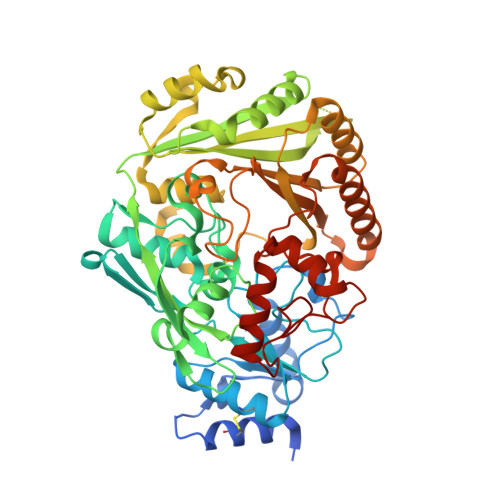Oxidation of Monolignols by Members of the Berberine Bridge Enzyme Family Suggests a Role in Cell Wall Metabolism.
Daniel, B., Pavkov-Keller, T., Steiner, B., Dordic, A., Gutmann, A., Nidetzky, B., Sensen, C.W., Van Der Graaff, E., Wallner, S., Gruber, K., Macheroux, P.(2015) J Biol Chem 290: 18770
- PubMed: 26037923
- DOI: https://doi.org/10.1074/jbc.M115.659631
- Primary Citation of Related Structures:
4UD8 - PubMed Abstract:
Plant genomes contain a large number of genes encoding for berberine bridge enzyme (BBE)-like enzymes. Despite the widespread occurrence and abundance of this protein family in the plant kingdom, the biochemical function remains largely unexplored. In this study, we have expressed two members of the BBE-like enzyme family from Arabidopsis thaliana in the host organism Komagataella pastoris. The two proteins, termed AtBBE-like 13 and AtBBE-like 15, were purified, and their catalytic properties were determined. In addition, AtBBE-like 15 was crystallized and structurally characterized by x-ray crystallography. Here, we show that the enzymes catalyze the oxidation of aromatic allylic alcohols, such as coumaryl, sinapyl, and coniferyl alcohol, to the corresponding aldehydes and that AtBBE-like 15 adopts the same fold as vanillyl alcohol oxidase as reported previously for berberine bridge enzyme and other FAD-dependent oxidoreductases. Further analysis of the substrate range identified coniferin, the glycosylated storage form of coniferyl alcohol, as a substrate of the enzymes, whereas other glycosylated monolignols were rather poor substrates. A detailed analysis of the motifs present in the active sites of the BBE-like enzymes in A. thaliana suggested that 14 out of 28 members of the family might catalyze similar reactions. Based on these findings, we propose a novel role of BBE-like enzymes in monolignol metabolism that was previously not recognized for this enzyme family.
Organizational Affiliation:
From the Institutes of Biochemistry.




















